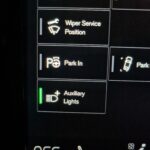Understanding your Toyota Corolla’s wiring diagram is crucial for any DIY car enthusiast. Whether you’re installing a new car stereo, troubleshooting electrical issues, or adding remote start functionality, a wiring diagram is your roadmap to success. This guide provides insights into various aspects of Corolla wiring, including tachometer, door trigger, domelight supervision, parking lights, brake wires, and door lock wiring.
Decoding the Toyota Corolla Wiring Diagram
A Corolla’s wiring can seem daunting at first, but breaking it down into sections makes it manageable. Let’s explore key areas:
Tachometer Wiring
Accessing the tachometer wire involves removing a plastic screw and the trim around the instrument cluster. The tach wire, typically black, is located on the left side of the plug at the top of the cluster.
Important Note: Cold weather can impact remote start functionality. High RPMs on a cold start might trigger over-rev protection. Ensure your unit’s over-rev protection is adjusted appropriately, or consider slightly depressing the gas pedal during tachometer programming.
Door Trigger Wiring
Several options exist for door trigger wiring:
- Driver’s Running Board: The red/yellow wire bypasses the door lock delay and allows for domelight supervision.
- Instrument Cluster: The red/white wire, near the tach wire, offers similar functionality.
- Dash Dimmer Switch: The red/white wire here is subject to the door lock delay but still allows domelight supervision. Note that only LE models typically have factory domelight delay.
Domelight Supervision
The dash dimmer switch often includes a domelight disable position. Domelight supervision can be wired before or after this switch. The red/black wire from the switch provides constant domelight supervision. Utilizing the door trigger wires mentioned earlier allows the driver to retain full control over the domelight. All domelight wires are high-current, requiring a relay for powering.
Note: The Corolla LE, with its woodgrain trim, typically features factory domelight supervision activated by the unlock wire. However, this might not function during remote start, necessitating aftermarket supervision.
Parking and Brake Wire Locations
- Parking Light Wire: The positive parking light wire (green) can be found at the dash dimmer switch or in the driver’s running board.
- Brake Wire: The green/white brake wire is located in the driver’s running board.
Bundling door trigger, parking, and brake wires together in the driver’s running board simplifies installation for remote start or alarm systems. For alarm-only installations on base models, connecting these wires at the dimmer switch is a viable option.
Remote Start Wiring Considerations
- Second Accessory Wire: The black/yellow wire powers the climate control system, essential for remote start.
- Accessory Wire (Radio): The blue/red wire powers the radio but isn’t crucial for remote start.
- Constant Wire: The white constant wire is thin. It’s recommended to connect constant wires to the car’s larger black constant wire.
Door Lock Wiring
- Door Lock: The green wire in either kick panel, activated by the door key cylinder, locks the doors.
- Two-Step Unlocking: For two-step unlocking, utilize the blue/yellow wire in the driver’s kick panel.
- Single-Step Unlocking: The blue/black wire in the passenger’s kick panel enables single-step unlocking, though it’s rarely needed.
Conclusion
Understanding your Toyota Corolla’s wiring diagram empowers you to confidently tackle various DIY projects. By carefully following the appropriate wiring schematics and taking necessary precautions, you can enhance your Corolla’s functionality and personalize your driving experience. Remember to consult your car’s specific wiring diagram for accurate information pertaining to your model year. Always disconnect the battery before working on any electrical components.

